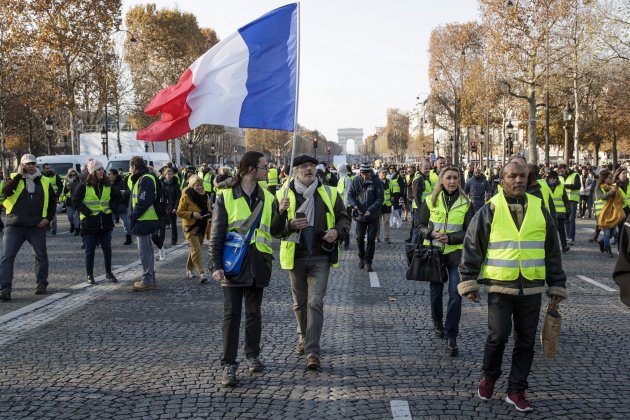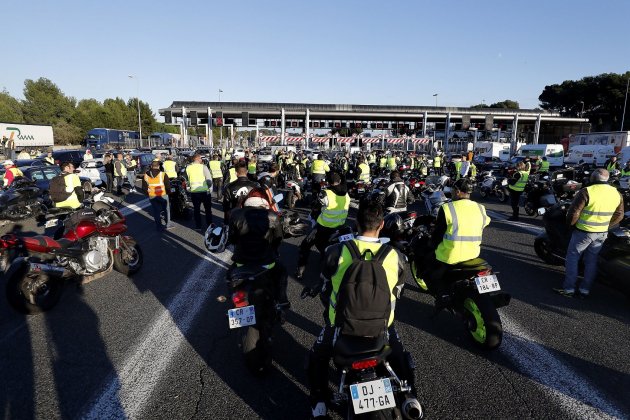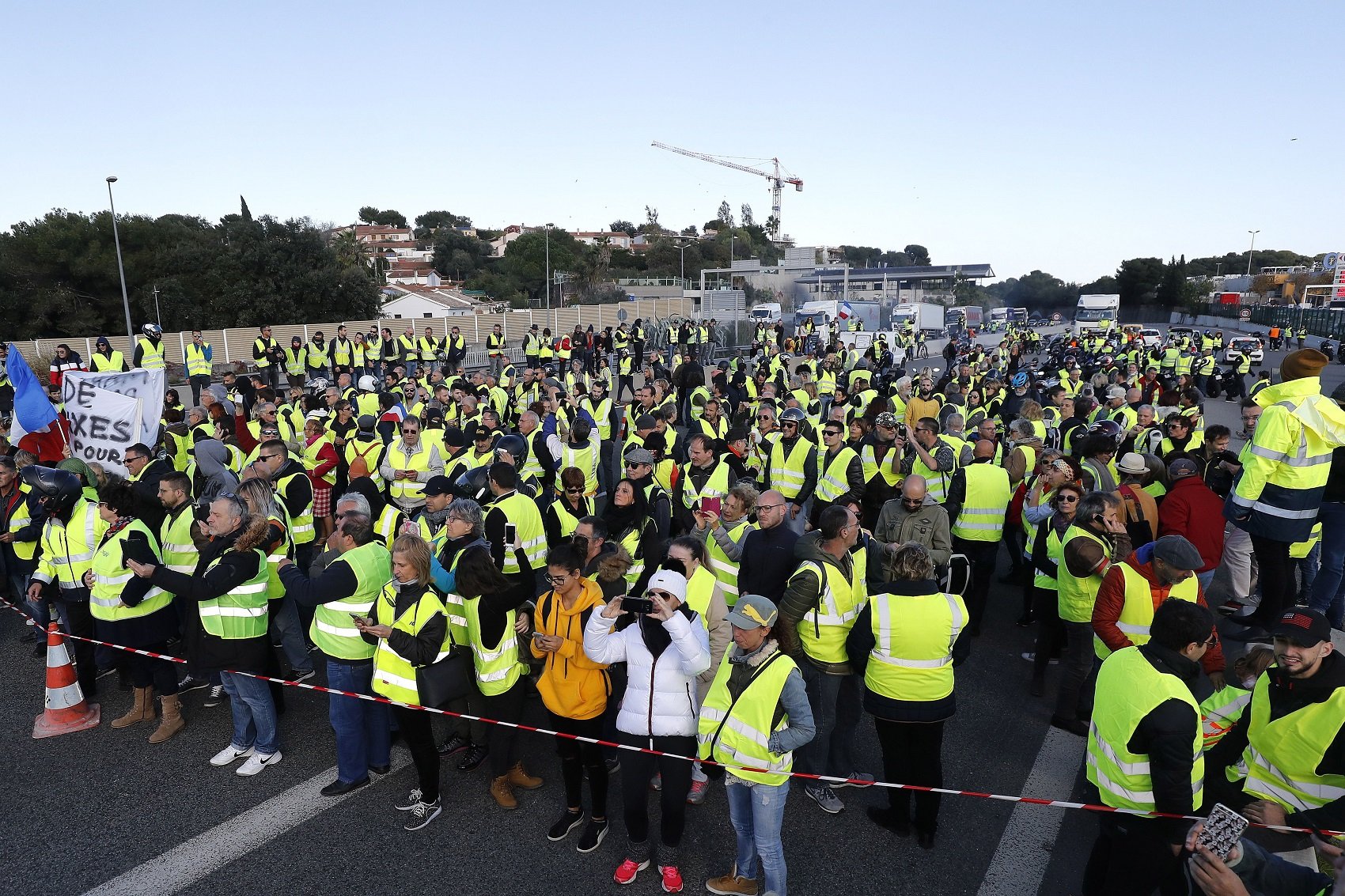A difficult Saturday in France. The country has lived through a day of vigorous protests against fuel tax rises. The movement, which has been dubbed the Gilets Jaunes - Yellow Vests - for the reflective clothing worn by participants, has blocked highways all over the country. More than 240,000 people have been taking part at more than 2,000 different points around the French republic, according to AFP. The style of the demonstrations is comparable to that of Catalonia's pro-independence groups, the CDRs, which have in the past used similar tactics of blockading transport routes - although in France, this has not provoked anything like the controversy it led to in the Spanish state.
#GiletsJaunes très nombreux à Déols. Un premier rond-point est bloqué. D autres à suivre. L’ambiance est bon enfant. pic.twitter.com/BQFMHGYwse
— NR Châteauroux (@nrchateauroux) November 17, 2018
However, the protest began on Saturday with the death of a demonstrator. A driver, who was taking her daughter to the doctor, found her way obstructed by a cordon of demonstrators, and when they blocked her way and began to bang on her vehicle, she appears to have panicked and tried to drive on, finally running over one of the protesters, as Euronews reported. The woman was arrested by police.
The French interior minister, Christophe Castaner, has announced that the protests have so far led to 47 injuries, three of them severe, as well as 24 arrests.
Why are they protesting?
The French government has decreed an increase in tax on transport fuels of 7.6 euro-cents per litre for diesel and 3.9 cents for gasoline. In addition, from January onward, new supplementary taxes will be applied of 6 cents and 3 cents per litre,for diesel and gasoline respectively.
In spite of the French government's announcement of a plan of state assistance of around 500 million euros to renovate France's vehicle fleet, the protests have not stopped.
#GiletsJaunes près de #Rouen : on peut parler, sans exagérer, de paralysie totale au rond-point des vaches. pic.twitter.com/zMA4rgLqxE
— simon louvet (@LouvetSimon) November 17, 2018
Many of the demonstrators live in the suburban extremities of the major French cities and affirm that the private car is the only means of transport that they have.
The protesters have called for the resignation of French president Emmanuel Macron, who they accuse of being concerned only with the elite and of abandoning the middle classes "to their fate".

Efe
Main routes affected
Some of the key highways affected have been those in the north of the country: highway N1338 at the Flaubert bridge in Rouen, the N814 at Caen, the N136 at Rennes, the A77 motorway at Bonny-sur-Loire, the N165 at Vannes, the A84 at Guilberville and A11 at Angers.
The protesters also blocked service stations and access to motorway tollbooths. Police had to intervene in a protest in Haute-Savoie, using tear gas.
Most of the protests had not been communicated to the authorities, and this hampered the police response.

Efe
Ironic reaction: "What would Spain have done?"
Meanwhile, the similarity between the style of the French protest - aimed at blockading transport networks - and that used in Catalonia by the pro-independence CDRs (Commitees for the Defence of the Republic), led to a wave of ironic comments on social media. What would happen if a protest on the massive scale and style of that by the French "yellow vests" were to take place in the Spanish state - given that some CDR members have been accused of terrorism by Spanish police, media and politicians?
Llarena procesando a media Francia: pic.twitter.com/Ay8GM2LBI3
— Bernat Castro (@Bernat_Castro) November 17, 2018
Translation:
[Catalan referendum-case judge] Llarena sends half of France to trial — Bernat Castro
Llevo un día un poco liado y no me he enterado d nada...
— Josep Lluis Berlanga 2.078.008 (@culebra1978) November 17, 2018
Ya ha llamado la TV francesa radicales y terroristas a las personas q hoy se han manifestado,han cortado carreteras y levantado peajes?
Ya les han aplicado la ley mordaza?
Ya ha salido el Rey de Francia a condenarlo?
Translation:
I've been a bit busy today and I haven't kept up with the news:
Has French TV already said that the people protesting, cutting roads and opening toll booths today are radicals and terrorists?
Have they already applied their repressive laws against the protesters?
Has the King of France spoken out to condemn them?— Josep Lluis Berlanga.
A França bloquegen autopistes, aixequen barreres i no els acusen de terrorisme.
— ᗩLᙖᙓᖇTᗟᙢ (@albertdmcat) November 17, 2018
A veure si prenem consciència de les barbàries de la justícia espanyola i som una mica més francesos en les protestes.
I que no siguin uns pocs, que desbordem el país.#AturemEspanya ENFONSEM-LOS!
Translation:
In France, they are blocking highways, opening barriers and they don't accuse them of terrorism. Let's see if we become aware of the barbarities of Spanish justice and become a little more French in our protests — albertdmcat
Highway cuts with sardanas
The mobilizations also created scenes like that filmed by Perpinyà newspaper L'Indépendant. One of the access routes to the Northern Catalonia capital was cut by a group that took the opportunity to perform the Catalan national dance, the sardana.
Au milieu de la voie rapide la Pénétrante à #Perpignan, moment de communion des #giletsjaunes66 autour d’une sardane. S’en suit le chant révolutionnaire dels Segadors. Bienvenue en pays catalan ! pic.twitter.com/wUpzdl2XJ0 — LIndep_Perpignan (@LIndep_perpi) November 17, 2018

